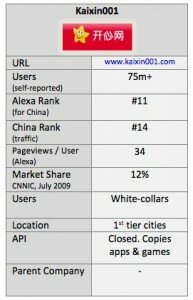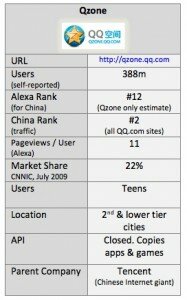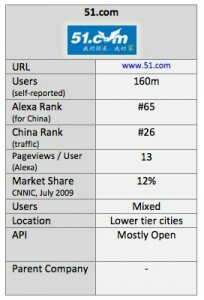China’s Top 4 Social Networks: RenRen, Kaixin001, Qzone and 51.com
Originally posted at VentureBeat
There is no single dominant network, no Facebook for all of China. The actual Facebook.com is blocked by government censors (Chinese sites all obediently and quickly remove “objectionable” content). No single social network will conquer the China market in the immediate future, least of all a foreign one. 
Instead, there is fierce competition between the top four:
- RenRen (formerly Xiaonei) copied the Facebook model: it started with students and has since opened to all.
- Kaixin001 attracted white-collar office workers by focusing on fun, addictive social games.
- Qzone gained young teens and rural users via cross-promotional traffic from QQ Messenger.
- 51.com started strong in lower tier cities, but growth has since slowed.
This post will assess market share, profile the top four, and boldly predict the future.
In addition, there is a long tail of social networks in China, which will be covered in part 2 of this series. Most Chinese are members of multiple SNS, on average 2.8, according to the Chinese Internet Network Information Center. A number of smaller SNS target niche demographics: the elite, females, techies, etc. The Chinese social network scene is crowded and competitive, though clear separation exists between the top four and ‘the rest’ in terms of mass-market viability.
Market Share: Lies, Damned Lies, and Statistics
There is no trustworthy data on users or revenues. Every social network in China claims to be the largest: Qzone, RenRen, Kaixin001, and 51.com. The short and sweet is this: Qzone has the most users, RenRen has the most active users, and Kaixin001 has the most highly active users. 51.com user’s are the most rural.
In addition to the rankings from Alexa and China Rank, the Chinese Internet Network Information Center conducted 3007 telephone interviews on SNS with respondents across China in July 2009. It found that Qzone has 22% market share of social network users, RenRen has 17%, Kaixin001 12%, and 51.com 12%.
 Kaixin001’s users are highly active. It averages 34 pageviews and 33 minutes spent on the site per user, numbers that are about twice as high as the competition. Kaixin001’s white-collars love surfing the site at work, and occasionally in their free time too.
Kaixin001’s users are highly active. It averages 34 pageviews and 33 minutes spent on the site per user, numbers that are about twice as high as the competition. Kaixin001’s white-collars love surfing the site at work, and occasionally in their free time too.
As scant as the user data is, that on revenues is even worse. The little data that the networks do release is questionable. Only rough snapshots are available of the positioning in China’s social network race.
Renren (formerly Xiaonei)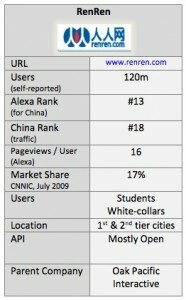
Renren’s design and business model are copied from Facebook. RenRen beat out a number of competitors at China’s elite universities and spread from there. It is aggressively courting the mass market.
Users: The majority of users are students, although RenRen strives to retain those users after graduation. In the fall of 2009, it launched a massive advertising campaign—both traditional and digital—urging Chinese to reconnect with old friends and classmates. The emphasis is on connecting with real-life friends online, just as on Facebook. As RenRen grows, it is encroaching on the turf of its rivals: teens (Qzone), white-collars (Kaixin001), and lower-tier cities (51.com).
User Interface: The user interface is nearly identical to Facebook (though it has not copied Facebook’s latest redesign). It has a few unique features, such as a “footprint” of who last visited your page and recently added game mechanics or 'funware' so that users can reach 'higher levels' for interacting on the site. It also allows custom skins, though the majority of users stay with the basic theme.
Platform: The application programming interface is open to 3rd parties, but revenue share is a capped at 56%. It boasts about 250 applications (almost all games) and is China’s most popular open platform. Foreign game developers are just starting to test the approval process, with FooMojo, RockYou, and PopCap leading the way. Access for foreign developers is certain to be a hot topic at the upcoming 2010 China Social Games Summit.
 Games: RenRen has the most and best games, in large part due to its open platform. But RenRen also develops games in-house, leading to concerns that RenRen will favor its own games over those of outside developers. Other networks often copy the most popular games on RenRen.
Games: RenRen has the most and best games, in large part due to its open platform. But RenRen also develops games in-house, leading to concerns that RenRen will favor its own games over those of outside developers. Other networks often copy the most popular games on RenRen.
Financing: Softbank purchased 35% of RenRen for $430 million, valuing the company at $1.2 billion. The company intends to hold an initial public offering as soon as 2011.
RenRen’s parent company is Oak Pacific Interactive, which also owns Mop, a smaller Chinese social network, forum, and humor site.
Revenues: Annual revenue was over 100 million RMB ($15 million) in 2009, according to one source from the company. The primary revenue channel is advertising (brands, games, and e-commerce).
Analysis: RenRen is the most popular, most open, and best-financed social network in China. Its management team is also the smartest and fastest-moving. It is actively developing advertising, gaming, and e-commerce revenues. Its user growth is impressive, in large part due to its aggressive marketing campaigns. The August 2009 name switch from Xiaonei (inside-campus) to RenRen (people’s web) signaled its ambition to become China’s dominant popular social network. By comparison, China’s other social networks are asleep at the wheel.
While RenRen was still concentrated on students, the upstart Kaixin001 was able to attract white-collar workers (in large part via spam).
Its social games got entire offices addicted to parking cars, stealing crops, and other top games. Its white-collar workers are the richest and most monetizable demographic of social network users. Kaixin001’s critical battle is ensuring that the next generation of students “graduate” to its site upon entering the workforce, rather than remaining with RenRen.
Users: White-collar workers who can secretly farm crops and check friends’ photos from their office desk. Its users spend twice as much time on site, as compared to users on the other social networks.
User Interface: The interface is clean and very simple—Kaixin001 is a pared-down version of Facebook. It eases first-time users into social network: the most popular applications, like the popular “Buying a House,” even come pre-installed. Advertising is minimal.
Platform: Kainxin001 is a closed platform, although insiders say that it will eventually open up. It has about 50 applications, the majority of which are games.
 Games: Kaixin001 launched the social games craze in China and its users are game-crazy. But its games now lag behind RenRen in quantity and quality, because it’s attempting to develop everything in-house. For instance, it took Kaixin001’s developers 6 months (an eternity in social game years) to copy a popular restaurant game on RenRen. That will damage Kaixin001 as it aims to attract new users and retain and monetize its existing users.
Games: Kaixin001 launched the social games craze in China and its users are game-crazy. But its games now lag behind RenRen in quantity and quality, because it’s attempting to develop everything in-house. For instance, it took Kaixin001’s developers 6 months (an eternity in social game years) to copy a popular restaurant game on RenRen. That will damage Kaixin001 as it aims to attract new users and retain and monetize its existing users.
Financing: Kaixin001 has received a total of $23 million through two funding rounds. Investors include Sina, Qiming Ventures, and Northern Light Venture Capital.
Revenues: Kaixin001 has reached monthly revenues of 7 million RMB ($1 million), but is not yet profitable. Advertisers at ad:tech Beijing told BloggerInsight that Kaixin001 is the hottest site.
Analysis: Kaixin001 has seen rapid growth and has captured a desirable demographic of white-collar workers (appealing to advertisers), who spend tons of time on the site. But its management team is far more conservative and slow-moving than RenRen. It’s far behind in terms of its advertising and monetization channels. Its site design has changed little and its application programming interface remains closed. If Kaixin001 fails to innovate or at least keep up with the curve, it will lose out. Sudents will stick with RenRen rather than “graduate” to Kaixin001.
Qzone draws traffic from QQ Messenger, which boasts 523 million active users and is also owned by Tencent. Qzone targets teens, rural, and casual users and claims a whopping 388 million active users, a highly suspect number. Tencent’s internet services, QQ Messenger, QQ Show, QQ Games, QQ Pet, and Qzone, do connect a huge number of Chinese people.
But the classification of Qzone as a social network is questionable. It has tons of dormant, skeleton profiles that are pulled from QQ Messenger. In that regard, it’s similar to MSN Spaces, which also has a ton of “users,” but low value and retention rates. Qzone users often use nicknames or aliases rather than real-life names.
Given Tencent’s awesome advantages and synergies in social networks, Tencent’s forays into “real-identity” social networking should be seen as a squandered opportunity.
Users: Teens and rural users. Qzone is attempting to funnel its older users towards its other social network, Xiaoyou (classmates), with limited success. It already failed with an earlier attempt called QQ Campus.
User Interface: Qzone is a lousy website: it’s ugly, unintuitive, and buggy. The site is very basic (for a social network), but not in a user-friendly way (like Kaixin001).
Platform: Qzone is a closed platform, though it is experimenting with licensing. It has about 50 applications (mainly games). Benjamin Joffe, Tencent expert and CEO of internet market research firm +8*, comments: “Applications are all copies or licenses or bought from social gaming companies, generally with terrible revenue share or poor valuation. Why? Because Tencent is a closed network and because they can. Problem is: operating social games is not the same as instant messaging or massive multi-player online games and there is a learning curve - even for Tencent.”
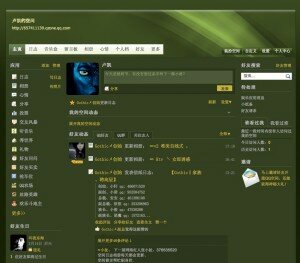 Games: Although Qzone should have a natural advantage (Tencent also owns QQ Games), the games, like much else on the site, are of low quality. Qzone develops in-house copies of popular games, but it lags way behind and prohibits users from adding games without paying at certain times. Perhaps Qzone’s comparatively young and rural users are so naïve that they pay Qzone when they can play the same—or better—games for free on the other networks. But it's doubtful that this a successful business strategy in the long run.
Games: Although Qzone should have a natural advantage (Tencent also owns QQ Games), the games, like much else on the site, are of low quality. Qzone develops in-house copies of popular games, but it lags way behind and prohibits users from adding games without paying at certain times. Perhaps Qzone’s comparatively young and rural users are so naïve that they pay Qzone when they can play the same—or better—games for free on the other networks. But it's doubtful that this a successful business strategy in the long run.
Financing: Tencent, Qzone’s parent company, is massively profitable and can employ incredible resources should it so desire.
Revenues: No public figures are released. There is a lack of advertising and quality games, so virtually all revenues must come from Qzone “Yellow Diamond” memberships. It is difficult to estimate that revenue stream, but it’s hard to imagine that too many Chinese users will stay loyal to Qzone in the long-run if they continue to offer lousy services.
Analysis: Tencent with Qzone is like Microsoft with Windows Vista: a near-monopolist (in instant messaging) that can thrive despite a terrible product and lack of vision. Tencent is still massively profitable: 2009 revenues were $1.8 billion, about three times Facebook’s estimated revenues. It’s unclear how much of that is attributable to the Qzone social network though.
Benjamin Joffe comments, “Tencent is definitely not the best in terms of products or innovation - similar to Zynga in that sense - but their ability to deliver a "good enough" mass market service and integrating it within their ecosystem is impressive.”
It holds the teen demographic, but poor site design and management have cost it ground against its competitors. Qzone is shut out of the market for older students and white-collar workers, and RenRen is now encroaching on its core demographic of teens. Qzone could still turn things around though, as its parent company Tencent is an 800-pound gorilla in the Chinese internet.
51.com was an early favorite with significant backing, but is now struggling. Growth has slowed and it has the lowest traffic rankings of the top four. In early January, the site was briefly blocked for “objectionable” content, so management is trying to clean itself of lewd users and content (it’s rumored to be a platform for the world’s oldest profession). Its Chief Strategy Officer recently resigned, citing illness.
51.com is a borderline mass-market contender at best. Urban and educated demographics have all turned to its competitors. It’s now in the precarious position of defending its core user base in lower tier cities.
Users: Users from lower tier cities.
User Interface: 51.com is a simple social network. It’s far more functional than elegant. Several popular applications are pre-installed and the skins are customizable.
Platform: 51.com offers an open platform. It has attracted about 50 applications (mostly games). It is expected to offer more favorable revenue share terms than RenRen.
 Games: The games on 51.com are decent, though not as numerous or high-quality as on RenRen. 51.com also develops its own games in-house: it’s investing $15 million in a gaming portal, in an attempt to reduce its reliance on advertising and value-added services. It will also soon connect into the gaming platform from Giant Interactive, one of its investors.
Games: The games on 51.com are decent, though not as numerous or high-quality as on RenRen. 51.com also develops its own games in-house: it’s investing $15 million in a gaming portal, in an attempt to reduce its reliance on advertising and value-added services. It will also soon connect into the gaming platform from Giant Interactive, one of its investors.
Financing: Giant Interactive, a publicly-listed Chinese massive multiplayer online gaming company, invested $51 million for a 25% stake. Earlier backers include venture capital firms Sequia Capital, SIG, Redpoint Ventures, and Intel Capital. In early 2007 there was premature talk of an IPO in 2010, but nothing has been heard since.
Revenues: 51.com claims to have turned a profit in 2009, with advertising revenues of about 200 million RMB ($29 million). Its open platform generated roughly 12 million RMB ($1.8 million) in revenues.
Analysis: 51.com was likely doomed to the mass-market by its rural roots. Its lower tier cities approach initially allowed for quick user growth, but the site now has a low-brow reputation and is scorned by more sophisticated netizens. RenRen’s approach of starting with the elite students at China's top universities, BeiDa and Tsinghua, and then spreading outward (copied from Facebook), appears to have been far more successful.
Second tier social networks worldwide are falling to Facebook. Will China’s more “sophisticated” networks push into 51.com’s territory? BloggerInsight is inclined to think so. 51.com’s stagnation in user growth relative to other networks is not a good sign; spreading outward from elite users has been successful for social networks worldwide and for RenRen in China too.
There are certainly differing opinions though. Beijing-based internet guru Kaiser Kuo told BloggerInsight, “I wouldn't write them off at all: They've got a real hold in sub-secondary cities and with their tie-up to a major game company (Giant Interactive), they've got plenty of cash, and as far as I know, loads of traffic. It's also been cleaned up quite a bit within the last year, from what I've heard.”
51.com may or may not hold its ground in lower tier cities. But one thing’s for certain: 51.com stands little chance in China’s top-tier cities.
Future Predictions: One RenRen to Rule them All?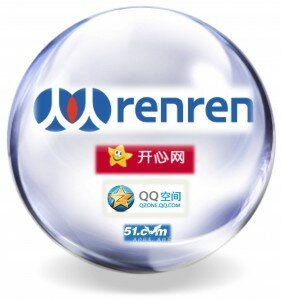
The competition is open and fierce between the top four networks, but BloggerInsight’s bold crystal ball sees RenRen’s on the rise in the future. Its management team is nimbler and more aggressive than its competitors. Where other networks are dabbling (licensing games), RenRen is blazing ahead (open application programming interface).
Because of its high value, RenRen is starting to push outward from university students into both younger and older demographics. As teens become savvier on the internet at younger ages, they will start to abandon Qzone for RenRen. As students move into the workplace they should remain loyal to RenRen, encroaching upon Kaixin001. 51.com, meanwhile, faces a difficult fight to retain its users in 2nd and 3rd tier cities and rural areas. China’s social network universe, though fractured by different demographics for now, may gradually coalesce around RenRen.
Kai Lukoff is an analyst at BloggerInsight and an editor on China Social Games. Follow Kai on Twitter
Pages
Categories
- English
- Game Analysis
- game developers
- Publishers
- Social Networks
- Top Social Games
- Uncategorized
- Virtual Currency
Blogroll
Archive
- September 2010
- August 2010
- July 2010
- June 2010
- May 2010
- April 2010
- March 2010
- February 2010
- January 2010
- December 2009
Meta
- Log in
- RSS
- Comments RSS
